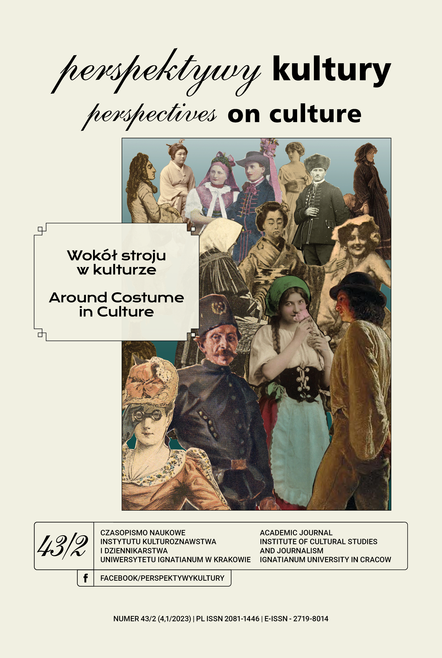Contemporary Muslim Women’s Clothing in the Light of e-Fatwas
Abstract
The article deals with the issue of women’s dress in contemporary Islamic culture. It aims to answer the question what of dilemmas Muslim women currently face when they wish to remain consistent with their religion, and what suggestions they receive when consulting legal and religious authorities on this issue. Sunni portals offering online legal advice (e-fatwa) were used as a reference point. Six of the most popular portals operating as global platforms for Muslim education were selected. The fatwas on women’s attire available there over the last 20 years were analyzed. The research shows that the vast majority of cybermuftis represent a conservative trend that rejects the possibility of reinterpreting the Qur’an and do not take into account the changing world and the new situations (including personal situations) in which women find themselves. Above all, there is a lack of openness, courage in argumentation and flexibility. The puritanical interpretation applies especially to Islamweb.net, Islamqa.info and Islamway.net, which turn out to be Salafi websites. Their influence can also be seen in the context of the other sites, i.e. Dar-alifta.org, Islamqa.org, Islamonline.net, which also have a strict approach in regard to women’s dress.
References
Abu-Rub H. i Zabża B. (2002). Status kobiety w islamie. Wrocław: Wydawnictwo Triada.
Abu Rumman, M. (2014). I am a Salafi. A Study of the Actual and Imagined Identities of Salafis. Amman: Friedrich-Ebert-Stiftung.
Al-Arna‘ut, Szu’ajb (red.). (2009AD/1430AH). Sunan Abi Dawud. Bajrut: Dar ar-Risala al-Alamijja, t. 6.
Belhaj, A. (2014). W: Z. Ali Shah (red.). Iftā’ and Fatwa in the Muslim World and the West. London – Washington: The International Institute of Islamic Thought, 49-72.
Bunt, G.R. (2003). Islam in the Digital Age. E-Jihad, Online Fatwas and Cyber Islamic Environments. London – Sterling – Virginia: Pluto Press.
Cesari, J. (2004). When Islam and Democracy Meet. Muslim in Europe and the United States. New York: Palgrave Macmillan.
Al-Chatib, Muhib ad-Din et al. (red.). (1400AH). Al-Dżami as-sahih li-l-Buchari. Al-Qahira: Al-Matba’a as-Salafijja wa-Maktabuha, t. 1 i 4.
Danecki, J. (2003). Kultura i sztuka islamu. Warszawa: Elipsa.
دار الإفتاء المصريةhttps://www.dar-alifta.org/ (dostęp: czerwiec – wrzesień 2022).
Egypt’s Dar al-Ifta. https://www.dar-alifta.org/Foreign/default.aspx?LangID=2&Home=1 (dostęp: czerwiec – wrzesień 2022).
Elias, J.J. (2012). Aisha’s Cushion. Religious Art, Perception, and Practice in Islam. Cambridge – Massachusett – London: Harvard University Press.
Al-Fatawa al-islamijja min Dar al-ifta al-misrijja (1980/1400-1997/1418). Al-Qahira: Matabi‘a al-Ahram at-Tidżarijja, t. 1-20.
Googletrends. https://trends.google.com (dostęp: wrzesień 2022).
Górak-Sosnowska, K. (2011). Muzułmańska kultura konsumpcyjna. Warszawa: Wydawnictwo Akademickie Dialog.
Hassan, Sh.A. i Wan, W.M.K.F. (2020). Research Design Based on Fatwa Making Process: An Exploratory Study. International Journal of Higher Education, 9 (6), 241-246. https://doi.org/10.5430/ijhe.v9n6p241
Hendrickson J. (2013). Fatwa. W: G. Bowering et al. (red.), The Princeton Encyclopedia of Islamic Political Thought. New Jersey: Princeton University Press, 173-174.
Internet World Stats (stan na 31 grudnia 2021). www.internetworldstats.com (dostęp: czerwiec 2022).
إسلام أون لاين https://islamonline.net/ (dostęp: czerwiec – wrzesień 2022).
Islam Online. https://islamonline.net/en/home/ (dostęp: czerwiec – wrzesień 2022).
إسلام ويب https://www.islamweb.net/ar/ (dostęp: czerwiec – wrzesień 2022).
Islamweb.net. https://www.islamweb.net/en/ (dostęp: czerwiec – wrzesień 2022).
IslamQA. https://islamqa.org/ (dostęp: czerwiec – wrzesień 2022).
إسلام سؤال وجواب https://islamqa.info/ar (dostęp: czerwiec – wrzesień 2022).
Islam Question & Ansewr. https://islamqa.info/en (dostęp: czerwiec – wrzesień 2022).
Islamway. https://en.islamway.net/ (dostęp: czerwiec – wrzesień 2022).
Kassem, M. (2014). Fatwa and the Era of Globalization, W: Z. Ali Shah, Iftā’ and Fatwa in the Muslim World and the West. London – Washington: The International Institute of Islamic Thought, 89-104.
Koran. (1986). Z arabskiego przełożył i komentarzem opatrzył J. Bielawski. Warszawa: PIW.
Kościelniak, K. (2006). Sunna, hadisy i tradycjoniści. Kraków: Wydawnictwo UNUM.
Lane E.W. (2003). Arabic-English Lexicon. CD-ROM ed. Vadus, Liechtenstein: Thesaurus Islamicus Foundation.
Linant de Bellefonds, Y. (1991). Ḍarūra. W: The Encyclopaedia of Islam. New Edition. Leiden: Brill, t. 2, 163-164.
Maruf, Baszszar Awwad (red.). (1996). Al-Dżami al-kabir li-t-Tirmizi, Bajrut: Dar al-Gharb al-Islamijj, t. 4.
Mehmood, M.I. (2015). Fatwa in Islamic Law, Institutional Comparison of Fatwa in Malaysia and Pakistan: The Relevance of Malaysian Fatwa Model for Legal System of Pakistan. Arts and Social Sciences Journal, 6 (3), 1-3. http://dx.doi.org/10.4172/2151-6200.1000118
Nalborczyk, A. (2008). Czy istnieje strój kobiety muzułmańskiej? W: J. Jurewicz, J. Rogala (red.), Szata oddaje ludzkie obyczaje, czyli o strojach ludów Azji i Afryki. Warszawa: Wydział Orientalistyczny UW, 61-71.
O’Donnell, L. (2022, 9 maja). The Taliban Have Made the Burqa Mandatory Again. Pozyskano z: https://foreignpolicy.com/2022/05/09/taliban-women-burqa-afghanistan-control/ (dostęp: czerwiec 2022).
Polka, S. (2019). Shaykh Yusuf al-Qaradawi. Spiritual Mentor of Wasati Salafism. New York: Syracuse University Press.
Prochwicz-Studnicka, B. (2013). Usul al-fiqh. Czym są klasyczne sunnickie „korzenie/podstawy wiedzy o prawie”? Czasopismo Prawno-Historyczne, 65 (1), 11-51. https://doi.org/10.14746/cph.2013.65.1.0.
Shah, Ali Z. (2014). Introduction, W: Z. Ali Shah (red.). Iftā’ and Fatwa in the Muslim World and the West. London – Washington: The International Institute of Islamic Thought, 1-10.
Similarweb. https://www.similarweb.com (dostęp: wrzesień 2022).
Skovgaard-Petersen, J. (2018). Historical Retrospective on Muftiship: Muftis, State Muftis and Official Muftis. W: E. Racius, A. Zhelyazkova (red.). Islamic Leadership in the European Lands of the Former Ottoman and Russian Empires, Leiden: Brill, 12-27.
Stillman, Y.K. (2003). Arab Dress. A Short History from the Dawn of Islam to Modern Times. Leiden – Boston: Brill.
طريق الإسلامhttps://ar.islamway.net/ (dostęp: czerwiec – wrzesień 2022).
Umar, Mustafa. (2012). Is Breathable Nail Polish Sufficient for Wuḍū’? Pozyskano z: https://mustafaumar.com/2012/11/is-breathable-nail-polish-sufficient-for-wu%E1%B8%8Du/ (dostęp: lipiec 2022).
Zabidi, T. (2019). Analytical Review of Contemporary Fatwas in Resolving Biomedical Issues Over Gender Ambiguity. Journal of Religion and Health, 58, 153-167. https://doi.org/10.1007/s10943-018-0616-0
Zaman, S. (2008). From Imam to Cyber-Mufti. Consuming Identity in Muslim America. The Muslim World, 98, 465-474. https://doi.org/10.1111/j.1478-1913.2008.00240.x
Copyright (c) 2023 Perspectives on Culture

This work is licensed under a Creative Commons Attribution 4.0 International License.
Autor, zgłaszając swój artykuł, wyraża zgodę na korzystanie przez Wydawnictwo Uniwersystet Ignatianum z utworu na następujących polach eksploatacji:
- utrwalania utworu w formie papierowej, a także na nośniku cyfrowym lub magnetycznym;
- zwielokrotnienia utworu dowolną techniką, bez ograniczenia ilości wydań i liczby egzemplarzy;
- rozpowszechniania utworu i jego zwielokrotnionych egzemplarzy na jakimkolwiek nośniku, w tym wprowadzenia do obrotu, sprzedaży, użyczenia, najmu;
- wprowadzenia utworu do pamięci komputera;
- rozpowszechniania utworu w sieciach informatycznych, w tym w sieci Internet;
- publicznego wykonania, wystawienia, wyświetlenia, odtworzenia oraz nadawania i reemitowania, a także publicznego udostępniania utworu w taki sposób, aby każdy mógł mieć do niego dostęp w miejscu i czasie przez siebie wybranym.
Wydawca zobowiązuje się szanować osobiste prawa autorskie do utworu.






